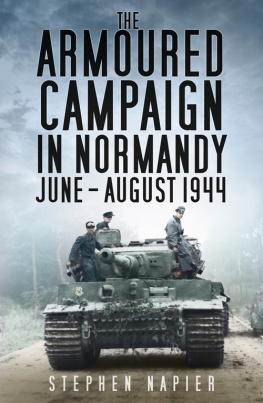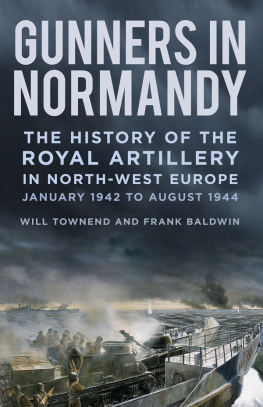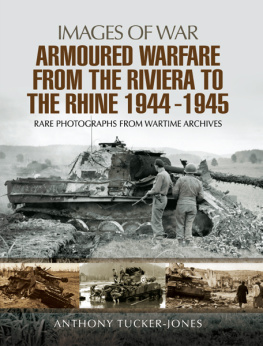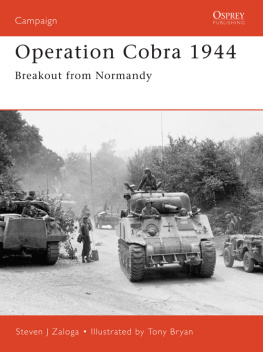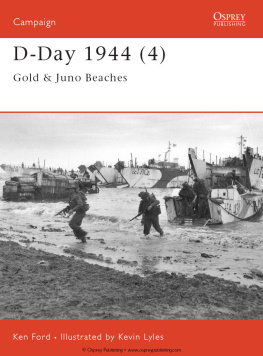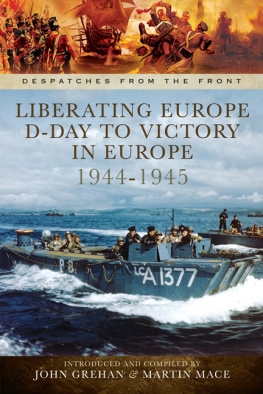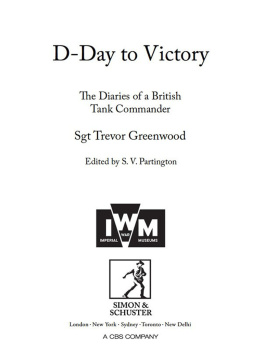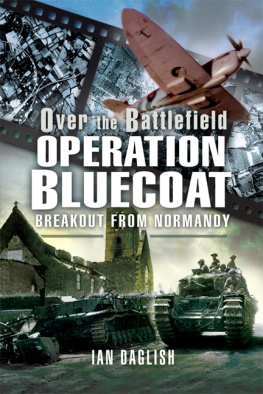From Arromanches to the Elbe
To those who served in 144th RAC/4th RTR 19445
From Arromanches to the Elbe
Marcus Cunliffe and the 144th Regiment Royal Armoured Corps 19441945
Charles More
From Arromanches to the Elbe
First published in Great Britain in 2019 by Frontline Books, an imprint of Pen & Sword Books Ltd, Yorkshire Philadelphia
Copyright Charles More, 2019
ISBN: 978 152671 065 9
eISBN: 978 152671 067 3
Mobi ISBN: 978 152671 066 6
The right of Charles More to be identified as the author of this work has been asserted by him in accordance with the Copyright, Designs and Patents Act 1988. A CIP catalogue record for this book is available from the British Library All rights reserved.
No part of this book may be reproduced or transmitted in any form or by any means, electronic or mechanical including photocopying, recording or by any information storage and retrieval system, without permission from the Publisher in writing.
Pen & Sword Books Ltd incorporates the imprints of
Pen & Sword Archaeology, Air World Books, Atlas, Aviation, Battleground,
Discovery, Family History, History, Maritime, Military, Naval, Politics,
Social History, Transport, True Crime, Claymore Press, Frontline Books,
Praetorian Press, Seaforth Publishing and White Owl
For a complete list of Pen & Sword titles please contact:
PEN & SWORD BOOKS LTD
47 Church Street, Barnsley, South Yorkshire, S70 2AS, UK.
E-mail:
Website: www.pen-and-sword.co.uk
Or
PEN AND SWORD BOOKS,
1950 Lawrence Road, Havertown, PA 19083, USA
E-mail:
Website: www.penandswordbooks.com
List of Illustrations
Honeys and Shermans near Caen, July 1944
B Squadron tanks near Caen, July 1944
Outside Noyers: good tank going
Preparations for Totalize, August 1944
Totalize: modern memorial at Cramesnil
Stonk Wood
A knocked-out Tiger in Stonk Wood
Robert Thorne
Regimental officers
Alan Jolly
Marcus Cunliffe
The Calonne at La Vallette
The Aftwaterings Canal
The Ardennes: Hotton War Cemetery
The Ardennes: the road to Verdenne
Buffaloes near Marienbaum
The Rhine crossing: a message from Montgomery
Illustration Acknowledgements
Every effort has been made to trace, where possible, the copyright holders and obtain permission to reproduce the photographs that appear in this book. When this has not been possible, the author and publishers would be glad to hear from copyright holders so that due credit can be given in future printings.
1, 2, 4, 7, 17 Regimental History
8, 9, 10, 11 Private Collection
16 Bovington Tank Museum
Other plates copyright Suzanne Richards
List of Maps
2.1 The Battle of Noyers, 1618 July 1944
3.1 Normandy, 25 July 13 August 1944
3.2 Operation Totalize: The British Attack, 78 August 1944
4.1 Advance to the Seine
5.1 The Low Countries, autumn 1944
5.2 The Ardennes, January 1945
6.1 Rhine Crossing, 234 March 1945
Acknowledgements
A number of people have helped me during the course of writing this book and, as always, it is a pleasure to acknowledge this help.
For preliminary advice on the archival research, I would particularly like to mention Leah Richardson of the Special Collections Research Center, Gelman Library, The George Washington University. Shannon Bridget Murphy was of great assistance with Marcus Cunliffes papers at the Gelman Library. Thanks also to Katie Thompson of Bovington Tank Museum Archives and to staff at The National Archives, Kew, and the Imperial War Museum.
Suzanne Richards took numerous excellent photographs; thanks also to Sam Richards for the loan of his camera. Martin Brown drew the maps, which he transformed from my very rough originals. And it was a pleasure to have the company of Suzanne and my wife Hilary in following the tank tracks of 144th RAC/4th RTR.
At Pen and Sword/Frontline Press, thanks to Martin Mace, Lisa Hoosan, Alison Flowers and Tara Moran for their work. Thanks also to Andy Cocks.
Chapter 1
Introduction
This book is about a British armoured regiment and its part in the Allied campaign to liberate Europe. It landed at Arromanches eight days after D-Day, fighting from then until the end of the war in Normandy, Holland, Belgium and Germany. It was one of many such regiments: a total of around forty served for all or part of the long campaign. For 144th Royal Armoured Corps (or 4th Royal Tank Regiment as it became), the campaign ended at midnight on 8 May 1945. Most of its troops and vehicles were near Bremen, but one of its squadrons had been assisting an American division which crossed the Elbe near Hamburg. The Regiment ended the war strung out on the road which ran between the two north German cities. It had been in action for almost eleven months.
The Regiment was different from many because its campaign was remarkably well documented. The documents start with the regimental war diary, which all units kept, and which is in The National Archives in Kew. The 144th RACs (the abbreviation will be used from now on) war diary is fuller than most, and is supplemented by a number of lengthy accounts of various operations which the Regiment undertook. These accounts are sometimes personal, and sometimes extended versions of the third person descriptions in the narrative war diary.
They are complemented by Blue Flash , the history of the Regiment published in 1952 by Alan Jolly, its C/O throughout the campaign.humorous style, one that is familiar to those acquainted with British Army regimental magazines. It is at times very funny, and I have quoted from it freely, my excuse apart from its humour being that it is a rare book which few readers of this one are likely to have come across.
My interest in the Regiment was first aroused because my father-inlaw, Captain Robert (Bob) Thorne, served in it. He was in command of A Echelon, which brought up supplies to the tank squadrons, and at the end of the war he received the MBE in recognition of his service during the campaign. In about 1990 I talked to him at length about his life, especially his army career, and recorded these conversations. These recordings, therefore, constitute another source.
Bob had mentioned that a young officer in the Regiment went on to become a well-known historian. The young officer was Marcus Cunliffe. Cunliffe became a distinguished historian of the USA, and something from his obituary in The Times in 1991 lodged in my mind that he had planned a novel based on his wartime experiences. However, for a number of years I pursued other interests. Then, a couple of years before writing this book, I put his name into Google and it threw up some fascinating information. As well as notes for the novel, his diaries and other material had been left to George Washington University. Subsequently I had some of these photographed (for practical reasons the notes for the novel were not included). This book has used the diaries he kept from August 1943 and went on keeping, with a gap in mid- to late 1944, until after the end of the war; they are supplemented by vignettes of particular scenes and personalities which had caught his attention and were written after the event. There is also an account by Cunliffe of Operation Totalize, a major operation in which the Regiment was involved, in The National Archives.



